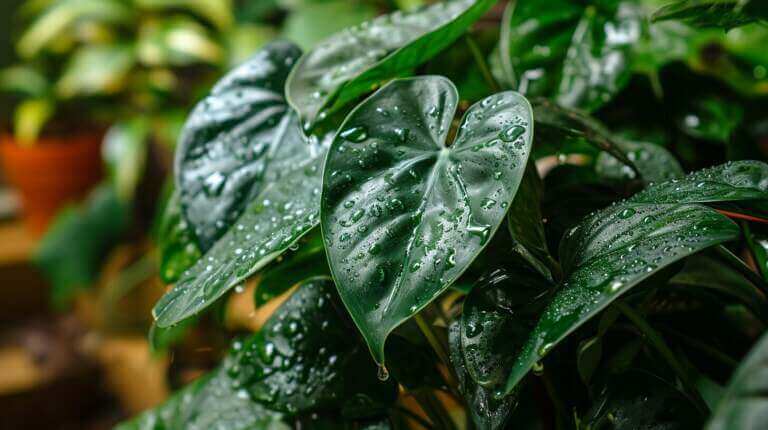Swiss cheese plants, including Monstera deliciosa and Monstera adansonii, have become popular indoor plants due to their striking appearance and ability to thrive in a variety of environments. To maintain a healthy plant, it is crucial to understand how to properly water your monstera, manage soil moisture, and provide the right amount of humidity. By following our watering advice, monitoring the humidity levels, and avoiding common problems like root rot and wilt, you’ll surely become a pro in houseplant care!
Key Takeaways
- Swiss cheese plants, such as Monstera deliciosa and Monstera adansonii, require proper care to remain healthy and thriving.
- Allow the top layer of potting soil to dry out between waterings, ensuring the roots do not sit in water and develop root rot.
- Monitor humidity levels to create the ideal environment for your Swiss cheese plant.
- Pay attention to the signs of overwatering, such as yellow leaves with brown spots and wilting.
- Keep your Swiss cheese plant away from temperature extremes and maintain a consistent indoor temperature for optimal health.
- Consistent care is essential for a lush, beautiful house plant.
- With patience and attention, anyone can master the art of Swiss cheese plant care.
The Quintessential Guide to Watering Your Monstera
When it comes to watering your Monstera, both Monstera deliciosa or Monstera adansonii, you must mimic the natural rainforest conditions they thrive in. These tropical plants have adapted to acquire moisture and nutrients from rainwater and the surrounding air in their natural habitat. The key is to keep the potting mix lightly moist but allowing the top layer of soil to dry out between waterings. Avoid letting your Monstera sit in water as they dislike soggy soil.
Monitor the light and temperature, as these affect how quickly the soil dries out. In lower light or cooler temperatures, your Monstera will require less frequent watering. During the growing season, your Monstera might require more water to support new growth. Be mindful to adjust your watering schedule to meet your plant’s needs, ensuring its root system remains healthy for thriving foliage.
“A well-watered Monstera has luscious green leaves and impressive aerial roots, ready to climb a moss pole or trail along a surface.”
Below is a handy table to guide you in adjusting your watering routine according to your indoor plant’s needs and environment.
| Condition | Adjustment |
|---|---|
| Lower light | Less frequent watering |
| Cooler temperature | Less frequent watering |
| Warmer temperature | More frequent watering* |
| Growing season | More frequent watering* |
*Increase watering frequency only if the top layer of soil is dry to avoid overwatering.
To ensure your Monstera plant’s well-being, monitor its humidity levels, which play an essential role in their growth. Excessive watering can lead to yellow leaves, while insufficient watering can cause wilting leaves. Make it a point to regularly check the soil moisture and adjust your watering routine accordingly. Providing the correct amount of water to your Swiss cheese vine can aid in maintaining healthy foliage and encouraging new growth all year round.
Creating the Ideal Humidity Oasis for Your Swiss Cheese Plant
Swiss cheese plants, with their tropical origins, flourish in environments with high humidity levels. They favor humidity akin to that found in tropical rainforests. To achieve this indoors, a humidifier can be employed to increase the moisture levels in the air, creating an environment that these plants find ideal. Misting can also help boost humidity for your Swiss Cheese plant, but it is usually not as effective as using a humidifier. It’s important to maintain consistent humidity without exposing the plant leaves to prolonged wetness, which can cause leaf problems. Regular use of a humidifier can mimic the Swiss cheese plant’s natural habitat, ensuring lush growth and health.
Striking the Balance with Humidifiers and Misting
Investing in a high-quality humidifier can greatly benefit your Swiss cheese plant, as it replicates the high humidity levels experienced in the tropical rainforest. However, it’s essential to strike the right balance in order to avoid over-moistening the plant. While misting the leaves can provide instant humidity relief for the plant, it may not offer enough moisture to maintain optimal humidity levels in the long run. Ensure the plant isn’t exposed to extreme temperatures and direct sunlight, which can negatively impact humidity levels and compromise plant health.
Companion Planting for Improved Humidity
A natural way to boost humidity levels for your Swiss cheese plant is through companion planting. By placing your Swiss cheese plant near other houseplants, especially those that also enjoy higher humidity, you can create a more humid microclimate. The collective transpiration from the plants can elevate the moisture levels in the surrounding air, benefiting all the plants involved. This method can help maintain the moisture that Swiss cheese plants crave without constantly adjusting humidity controls.
Pebble Trays and Other DIY Humidity Hacks
For a low-tech solution to improve humidity around your Swiss cheese plant, pebble trays can be quite effective. Fill a shallow tray with pebbles and add water just below the top of the pebbles. Place the plant’s pot on top, ensuring it doesn’t sit directly in water. The water in the tray will evaporate, adding moisture to the air surrounding the plant. This DIY method can help maintain ambient humidity levels, particularly useful if you find that the indoor air is too dry for your Swiss cheese plant.
For additional DIY humidity hacks, ensure that the plant is placed away from direct sunlight and drafts, which can lower humidity and stress the plant. Grouping plants together and maintaining proper indoor plant care can significantly improve the humidity levels in your indoor jungle, encouraging healthy foliage and an overall thriving Swiss cheese plant.
Shielding Your Monstera from Temperature Extremes
Protecting a Monstera, whether it’s Monstera deliciosa or Monstera adansonii, from temperature extremes is vital for its well-being. These plants flourish best when kept within a temperature range of 65-85°F, as this mirrors the warm and stable conditions of their natural tropical jungle habitat. Avoid sudden temperature fluctuations which can stress the plant—consistency is key. Be cautious of too much exposure to cold drafts or heat sources (like radiators), which can cause leaf discoloration and wilting.
In extreme heat, provide shade and increase watering frequency, while in cold, move the plant to a warmer area and reduce watering slightly. Encourage blooming and support overall plant health by maintaining a stable indoor temperature, shielding your Monstera from the temperature stress of both chills and heatwaves, akin to the care provided to a beloved green friend.
As a proud Monstera parent, I recognize that temperature plays a crucial role in my green friend’s happiness. Both the Swiss cheese vine and its popular cousin thrive when exposed to consistent warmth, which lays a strong foundation for their overall health. By carefully monitoring the indoor temperature and making necessary adjustments to accommodate the plant’s needs, we can make sure our Monsteras flourish and grow into gorgeous statement pieces within our indoor jungles.
So, remember to shield your Monstera from extreme temperatures and be vigilant about preventing temperature stress. This way, you can ensure your cherished plant friend thrives, bringing life and beauty into your home while reflecting the love and care you give it.
FAQ
How often should I water my Swiss cheese plant?
There is no specific schedule for watering Swiss cheese plants, as it depends on factors such as temperature, humidity, and light. Keep the potting mix lightly moist but allow the top layer of soil to dry out between waterings. During the growing season, increase water frequency to support new growth. Monitor your plant’s specific needs and adjust accordingly.
What causes yellow leaves on a Swiss cheese plant?
Yellow leaves on a Swiss cheese plant can result from overwatering or underwatering. Overwatered plants often have yellow leaves with brown spots, while underwatered plants have dry, yellow leaves. Assess the moisture level in the pot and adjust your watering schedule to remedy the issue.
How do I maintain the ideal humidity level for my Swiss cheese plant?
You can maintain an ideal humidity level for your Swiss cheese plant through various methods like using a humidifier, misting the leaves, employing companion planting, or utilizing pebble trays. Choose the method that works best for your plant’s specific needs and indoor environment.
Can I use companion planting to improve the humidity for my Swiss cheese plant?
Yes, placing your Swiss cheese plant near other houseplants that enjoy higher humidity can create a more humid microclimate, benefiting all the plants involved. The collective transpiration from the plants elevates the moisture levels in the surrounding air.
What temperature should I keep my Monstera at for optimal growth?
Both Monstera deliciosa and Monstera adansonii thrive best when kept within a temperature range of 65-85°F. This mirrors the warm and stable conditions of their natural tropical jungle habitat. Avoid sudden temperature fluctuations, cold drafts, and heat sources that can cause leaf discoloration and wilting.







